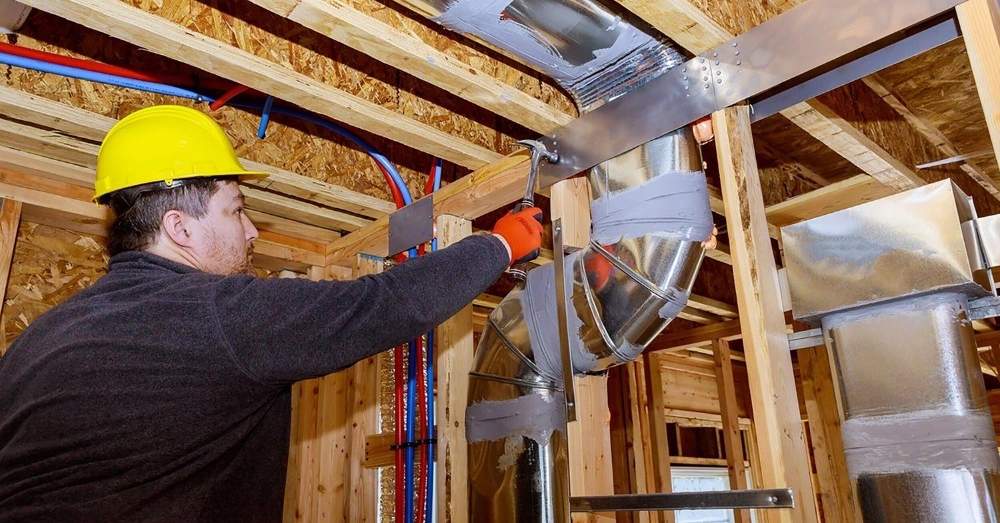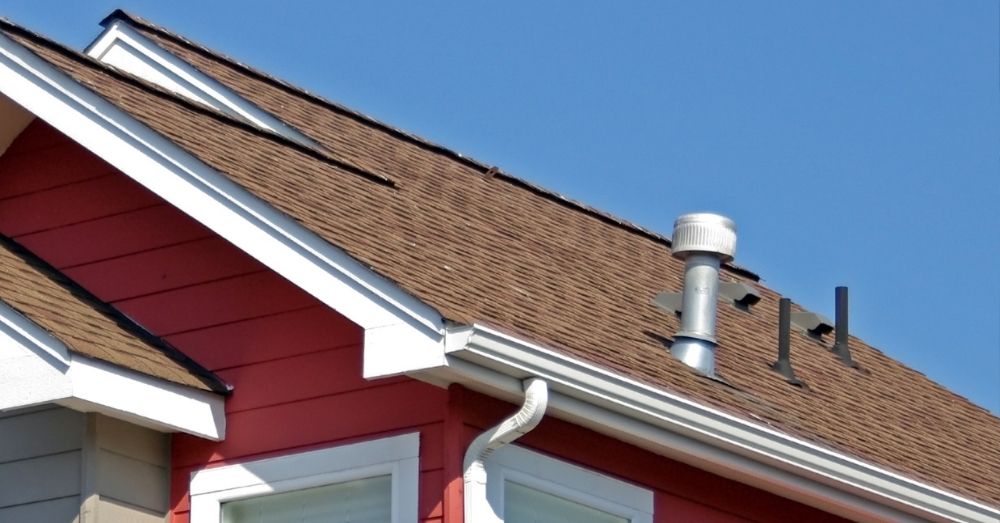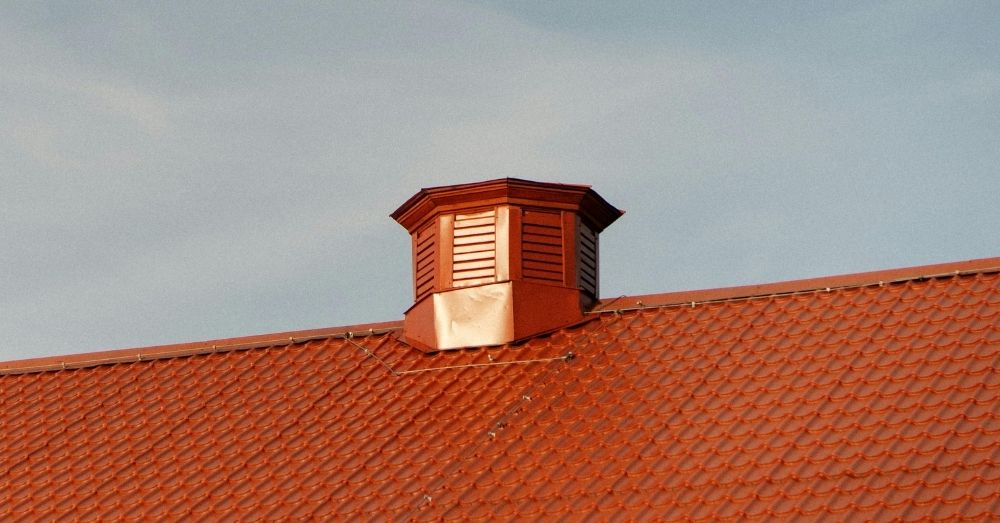
Roof vents are a small but essential part of any roof system, quietly working to keep a building’s structure healthy and efficient. They allow heat, moisture, and stale air to escape while pulling in fresh air, which helps regulate attic temperatures, reduce energy costs, and protect materials from damage over time. Without proper ventilation, issues like mold, ice dams, and premature roof wear can quickly develop, leading to costly repairs and discomfort indoors.
Here are the key functions of roof vents, why they matter, and how they work to keep a roof and home in top condition.
Table of Contents
Key Takeaways
✔ Roof vents are essential for regulating attic temperature and moisture to protect the roof’s structure.
✔ Understanding what the vents on the roof are helps homeowners see their impact on comfort and efficiency.
✔ Different types of vents, like ridge, soffit, box, and turbine, work together to create balanced airflow.
✔ Proper ventilation reduces energy costs and prevents issues like mold, ice dams, and premature shingle wear.
✔ Knowing how many roof vents are needed depends on attic size, roof design, and climate conditions.
✔ Professional installers familiar with who installs roof vents ensure correct placement and long-term performance.
✔ Routine maintenance, cleaning, and inspections keep roof vents working efficiently year-round.
✔ Investing in quality roof vent installation can extend roof life and increase overall home value.

What Are the Vents on My Roof?
When people wonder what the vents on the roof are, they are referring to openings designed to move air in and out of a home’s attic or upper spaces. These vents come in several styles—ridge vents running along the peak, soffit vents under the eaves, box vents, turbines, and even powered options—and each serves the same core purpose: balancing airflow to control heat and moisture. By letting hot air escape and cooler air enter, roof vents help protect shingles, reduce energy strain, and prevent issues like mold or ice dams. They may seem simple, but these components play a major role in the overall health and longevity of a roof.
5 Reasons Why Roof Vents Matter
1. Roof Vents Regulate Heat and Moisture
Understanding what the vents on the roof are goes beyond knowing they exist; they are critical for keeping a roof and attic balanced year-round. By allowing trapped heat and moisture to escape, they help maintain a stable environment under the roofline. This prevents structural issues, protects materials, and improves indoor comfort.
How Roof Vents Maintain Balance
- Prevent Heat Buildup in Summer: Without proper ventilation, attic spaces can reach extreme temperatures, bake shingles, and increase strain on cooling systems. Roof vents release hot air, reducing energy costs and protecting roofing materials from early wear.
- Reduce Moisture Problems in Winter: Cold weather can cause moisture to condense in attics, leading to mold, mildew, and even wood rot. Vents allow damp air to escape, protecting insulation and structural elements from long-term damage.
- Extend the Life of the Roof: Balanced airflow reduces stress on roofing components and prevents issues like ice dams or warped decking. A professional—someone trained in installing roof vents—can ensure vents are properly placed to get the best results.
2. Roof Vents Improve Energy Efficiency
Learning what the vents on the roof are often leads to understanding how they reduce energy strain. A roof without proper airflow forces heating and cooling systems to work harder, leading to higher energy bills and unnecessary wear on equipment. When installed correctly by experts familiar with who installs roof vents, these small components have a big impact on overall efficiency.
Why Roof Vents Lower Energy Use
- Keep Attics Cooler in Summer: Vents release trapped heat, keeping attic temperatures closer to the outside air. This reduces how much an air conditioning system must run, lowering cooling costs.
- Protect Insulation Performance: Moisture buildup can weigh down or damage insulation, making it less effective. Vents let damp air escape, ensuring insulation stays dry and able to do its job year-round.
- Support Consistent Indoor Comfort: Balanced airflow prevents hot and cold spots throughout a building. This consistency helps HVAC systems work more smoothly and last longer.

3. Roof Vents Prevent Costly Damage
Anyone asking what the vents on the roof are should also know that they help protect a home’s biggest investment. Poor ventilation allows moisture to linger, leading to rot, mold, and even compromised structural integrity. Partnering with professionals who understand who installs roof vents can save significant repair costs over time.
How Roof Vents Protect the Structure
- Prevent Mold and Mildew Growth: Moist, stagnant air creates the perfect environment for mold. Vents help circulate fresh air, keeping attic spaces dry and healthy.
- Reduce Risk of Ice Dams: In cold climates, trapped heat can melt snow on the roof, causing refreezing at the edges. Proper ventilation maintains even roof temperatures, reducing the risk of damaging ice dams.
- Protect Roofing Materials: Excessive heat and moisture shorten the life of shingles and decking. Vents relieve this pressure, helping materials last closer to their intended lifespan.
4. Roof Vents Extend Roof Longevity
A well-ventilated roof lasts longer, making the answer to what the vents on the roof are more valuable than ever. They act as a safeguard, maintaining a stable environment for shingles, underlayment, and structural supports. Choosing professionals who know who installs roof vents ensures vents are positioned for maximum benefit.
Why Vents Add Years to a Roof
- Relieve Stress on Materials: Roof vents help avoid the daily expansion and contraction caused by extreme temperature swings. This steadier environment means fewer cracks, warping, or premature failures.
- Protect Against Hidden Damage: Moisture can quietly damage sheathing or rafters without visible signs until it’s too late. Ventilation allows these areas to stay dry, preserving the structure.
- Support Warranty Compliance: Many roofing warranties require proper ventilation. Installing the right vents with qualified professionals keeps warranties intact and adds peace of mind.
5. Roof Vents Increase Home Value and Safety
Understanding what the vents on the roof are is also about seeing the bigger picture: they add value. A roof that breathes properly signals a well-maintained home, reducing future risks and appealing to potential buyers. Having qualified installers who know who installs roof vents ensures the system is safe, functional, and attractive.
How Vents Add Value and Security
- Improve Resale Appeal: Homebuyers look for signs of care, and a ventilated roof stands out as a sign of smart maintenance. It can make a home more competitive in the market.
- Enhance Fire and Safety Protection: Hot, trapped air and moisture can create hazards, especially near wiring or older building materials. Proper ventilation minimizes those risks.
- Showcase Professional Care: A system installed by trained experts assures future owners that the roof meets industry standards. This level of detail boosts confidence and property value.
How Many Roof Vents Do I Need?
Determining how many roof vents are needed depends on the size and design of the home, attic space, and local climate. Most roofing professionals follow a common rule: one square foot of ventilation (split between intake and exhaust) for every 300 square feet of attic floor space when a vapor barrier is present, or one square foot for every 150 square feet without it. The right number of vents ensures proper airflow, prevents moisture buildup, and extends the life of roofing materials. Because each roof has unique slopes, layouts, and obstacles, it is best to work with an experienced contractor to assess the structure and decide how many vents will keep the roof performing at its best.
How to Install Roof Vents
The roof vents market is projected to reach USD 3.5 billion by 2033, highlighting growing demand for proper ventilation solutions. Meeting this demand requires skilled installation, as roof vents must be placed with precision and safety in mind. While some homeowners may wonder how to install roof vents, the process is best left to trained professionals who can ensure accuracy and prevent costly mistakes.
1. Assess the Roof and Attic
A professional begins by examining the roof’s size, pitch, and attic conditions to determine the best approach. This assessment helps decide how many roof vents are needed and which types will work best for intake and exhaust. Proper planning ensures balanced airflow and long-term roof health.
2. Choose the Right Vent Types
Not all roofs require the same vents; options include ridge vents, box vents, turbine vents, and powered vents. A contractor evaluates the building’s design, climate, and ventilation needs before recommending solutions. This step ensures how to install roof vents aligns with both performance and code requirements.
3. Prepare the Installation Area
Professionals mark and cut precise openings in the roof decking, taking care to avoid rafters, wiring, or plumbing. They also inspect for any existing damage that could affect the vent’s placement. Accuracy here prevents leaks and maintains structural integrity.
4. Install the Vents
With openings ready, the installer secures the vents using manufacturer-recommended fasteners and flashing. Proper sealing is critical to prevent water intrusion and maintain energy efficiency. By relying on a qualified installer, the vent system functions exactly as intended.
5. Balance Intake and Exhaust
Ventilation works only when intake and exhaust are balanced. Experts ensure soffit vents, ridge vents, and other components are proportioned correctly based on how many roof vents are needed for optimal airflow. This balance prevents problems like moisture buildup or heat pockets in the attic.
6. Final Inspection and Maintenance Tips
Once vents are in place, a professional checks seals, flashing, and airflow to confirm everything is operating correctly. They also explain how to install roof vents properly and recommend routine checks to keep the system working efficiently. Ongoing maintenance and periodic inspections protect the investment and extend the life of the roof.

Maintaining and Cleaning Roof Vents
The average cost to install a roof vent is $475, making it an investment worth protecting. To keep that investment working at its best, it’s important to understand what the vents on the roof are, keep them clear of debris, and follow regular maintenance steps. Hiring professionals who know who installs roof vents is often the safest way to ensure long-term performance and avoid costly problems.
1. Schedule Regular Inspections
Roof vents can become clogged or damaged over time without visible warning signs. Having a roofing expert inspect vents at least once or twice a year ensures airflow remains balanced and issues are caught early. This is also a chance to confirm how many roof vents are needed is still correct as the home ages.
2. Remove Debris and Dirt
Leaves, twigs, or nests can block ventilation and reduce efficiency. Professionals or homeowners with proper safety gear can clear these obstructions to restore airflow. Clean vents also keep pests out and protect attic insulation.
3. Check for Rust, Cracks, or Damage
Metal vents can rust, while plastic or aluminum vents can crack under harsh weather. Inspecting for wear helps avoid leaks and structural problems. Any damaged vent should be replaced promptly by someone trained in who installs roof vents to maintain the system’s integrity.
4. Clean the Soffit and Intake Vents
Intake vents are just as important as exhaust vents for balanced airflow. Dust and insulation fibers can build up, reducing the system’s effectiveness. A professional cleaning keeps air moving freely, supporting the entire ventilation system.
5. Monitor Attic Conditions
Attic heat, moisture, and odors can indicate poor ventilation or blocked vents. Checking these conditions regularly helps maintain comfort and protect roof materials. This is where understanding what the vents on the roof are becomes crucial for diagnosing issues.
6. Know When to Upgrade or Replace
Even with good care, vents eventually wear out or become outdated. Upgrading to newer models or adding additional vents may be necessary, especially if how many roof vents are needed has changed due to renovations or insulation updates. Relying on experienced installers ensures replacements are done safely and correctly.

Frequently Asked Questions (FAQs)
Roof vents are not designed as soundproofing tools, but they can indirectly reduce noise by stabilizing air pressure and preventing rattling in the attic. Balanced ventilation helps minimize vibrations that may cause loose materials to shift or creak. Properly installed vents also allow HVAC systems to run more efficiently, reducing the noise of overworked equipment. While the impact is small, a well-ventilated roof can make the home feel quieter and more stable.
Yes, roof vents can improve indoor air quality by allowing fresh air to circulate through the attic and reducing stale or humid conditions. When hot or damp air is trapped, it can lead to mold and mildew that affect air inside living areas. A good ventilation system limits these risks by moving moisture and pollutants out. This makes vents an important part of a healthy, comfortable home environment.
Some roofing materials, like asphalt shingles or metal, are easier to pair with modern ventilation systems. Clay or slate tiles can still be vented, but they may require specialized installation methods to maintain integrity. The type of material impacts where vents can be placed and how they are secured. A qualified contractor ensures the right system is used for each roof type without compromising durability.
Yes, many vents can be painted as long as the paint is compatible with the vent’s material. Painting helps the vent blend with the roofline, improving curb appeal. However, it’s important to use a paint that will not block airflow or damage the vent’s protective coating. A professional can recommend safe finishes and ensure performance is not affected.
In regions with high winds, heavy rain, or hurricanes, vents must be secured and sometimes upgraded for added protection. Certain models come with features like wind baffles or stronger flashing to keep water and debris out. Poorly installed vents can be a weak point during storms, leading to leaks or damage. Consulting an installer familiar with local weather challenges ensures the venting system stays reliable in severe conditions.
Protect and Improve Your Roof with Lyndsey Roofing, LLC in Poughkeepsie, NY
At Lyndsey Roofing, LLC, we believe a strong, well-ventilated roof is the key to protecting a home and everything inside it. Our team proudly serves Poughkeepsie, NY, with expert roof vent installation, repair, and maintenance, using the right tools and techniques to keep airflow balanced and materials safe. Every project is handled with care, from assessing ventilation needs to ensuring long-term durability. Whether it’s upgrading an older system or adding new vents for better efficiency, our licensed and insured professionals are ready to get the job done right.
Call today to schedule a consultation and see why homeowners trust Lyndsey Roofing, LLC for quality roofing solutions that last.







